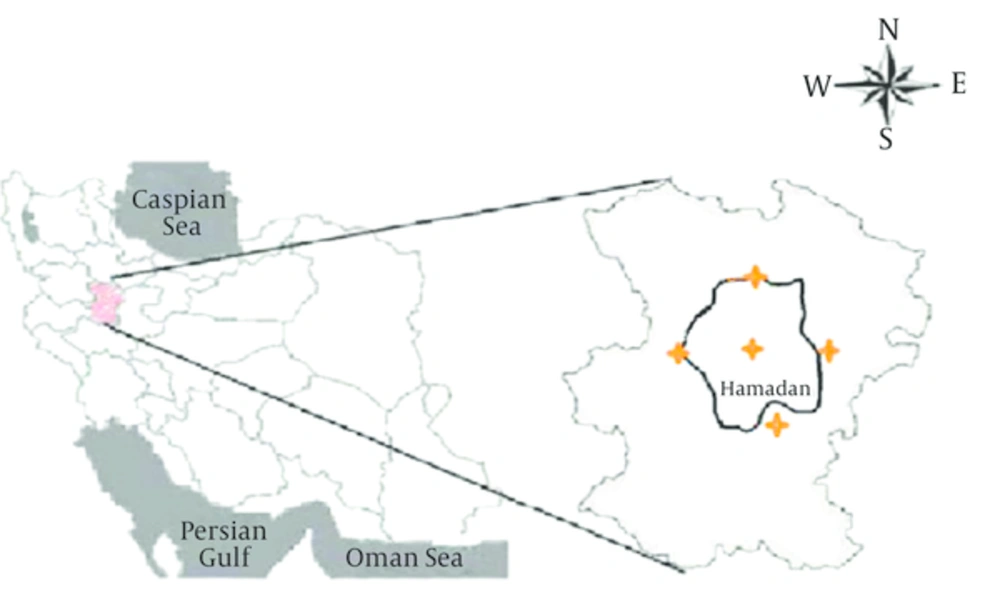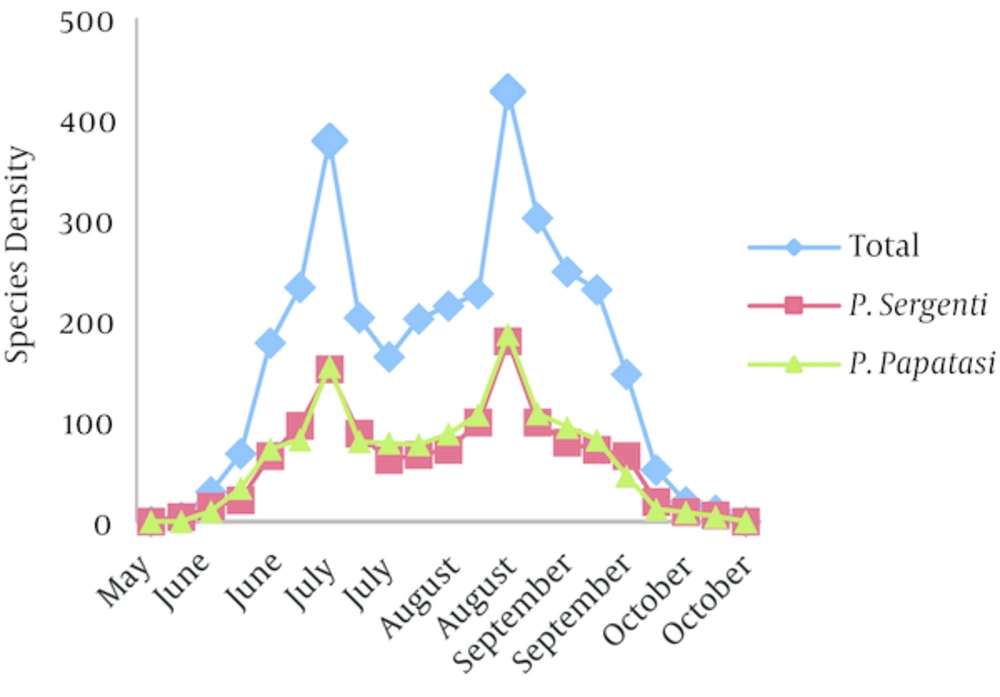1. Background
Phlebotminae sand flies are considerable public health problem because of their ability to transmit several pathogenic organisms to humans and other animals [1]. During past 30 years, important advances have been made in understanding the biology and the ecology of Phlebotminae sand flies and their importance to transmission of bartonellosis, phleboviruses, vesiculoviruses and specially leishmaniasis [2]. Two forms of leishmaniases in Iran are VL (visceral leishmaniasis) and CL (cutaneous leishmaniasis) [3]. CL is the most prevalent leishmaniasis in the world [4]. CL is endemic in 88 countries in Africa, Asia, Europe, North and South America, 90% of all cases take place in six countries that including Afghanistan, Brazil, Iran, Peru, Saudi Arabia and Syria [5].
VL is public health problem in Iran and some other countries [3]. Also sand flies cause annoyance by their painful bites, which may produce allergic reactions [6]. Of approximately 900 sand fly species in the world, about 50 have been concerned as vectors of leishmaniasis [7].
In the old world, Phlebotomus papatasi and Phlebotomus sergenti are recognized as the main vector of CL [3]. Species of Sergentomyia feed predominantly on reptiles, but the Phlebotomus feed mainly on mammals [8].
The ecological aspects of the leishmaniasis vectors have not been examined in Hamadan district yet. Without correct identification of sand flies species and their ecological aspects, prevention and control of leishmaniasis is difficult to achieve.
2. Objectives
The objectives of the present study were to determine the sand flies species population density, seasonal activities and hourly pattern of activities.
3. Materials and Methods
This is a descriptive cross-sectional study. The city of Hamadan is the center of province (34° 52’ N, 48° 35’ E) with an area of 4,084 km2. It is located at an altitude of 1,820 meters above sea level. The climate is basically cold and semidry. The maximum registered temperature is 38°C and minimum -25°C in July and February, respectively. The minimum mean monthly relative humidity is 43.33% (August) and the maximum is 77.22% (January). The study was conducted in 5 ecotypes (Figure 1). Sand flies were collected weekly from indoor (toilets and stables) and outdoor (around the houses, walls, rodent burrows, mountain and rock rifts), using sticky traps (castor oil coated white paper 20 × 32 cm) from the beginning (May) till the end (October) of the active season. Basic environmental conditions, including temperature and relative humidity, were recorded daily in each site with digital min-max thermometer/hygrometers. To determine hours of activity from sunset to sunrise, traps were installed and collected every 2 hours and were repeated 5 times in active season in one of the most populated collection sites. Traps were installed at 18:00 pm and run until 06:00 am the following morning. Then traps containing insects were collected and transported to the laboratory in Hamadan. For species identification, sand flies were mounted in Puri’s medium and identified after 24 hours, using the keys of Mesghali [9] and Nadim and Javadian [10].
3.1. Statistical Analysis
The χ2 tests were applied to analyze the data. All analyses were performed by SPSS 16 software and Excel 2007. Levels of P value equaled to or less than 0.05 considered as significant.
4. Results
In this study the max registered temperature was 31°C and min 13°C, respectively. The minimum mean monthly relative humidity was 38% and the maximum was 62%. Three thousand three hundred and five sand flies (68.9% males and 31.1% females) including nine species were captured: P. sergenti (38%), P. papatasi (36.6%), P. major (10.1%), P. kandelakii (6.7%), P. wenyoni (5.0%), P. caucasicus (1.2%), P. halepensis (0.1%), Sergentomyia dentata (1.2%) and S. sintoni (1.1%). No sand flies were caught until 25 May. P. sergenti was the most abundant species which contained 68.2% of all males and 31.8% of all females. Findings showed that the monthly activity of species began in late May and ended in early October with two peaks of activity in July and August, respectively (Figure 2).
The highest total frequencies, considering all the species captured over the one year, was observed in the summer (from 23 July to 30 August), with 81.8% of the specimens. P. sergenti almost was captured in all sampling, whereas P. halpensis was captured only in the warmest periods of activity season, exclusively in mountainous areas. The number of sand flies caught from indoor and outdoor places were respectively 755 (22.8%) and 2550 (77.2%). Regarding hourly activity, two very clear peaks of activity could be identified, one close to dusk (20:00 - 24:00 pm) and another at dawn (04:00 - 06:00 am), the second peak was not as high as the first peak. Activity of sand flies at dawn could be seen only in July and August.
5. Discussion
The present study resulted in the capture of 3,305 phlebotomines, representing 9 species. The activity of sand flies in Hamadan and vicinity started from May until October. Sand flies population showed two peaks in mid-July and late August. This is the first report of ecological aspects of sand flies in the Hamadan city and vicinity.
Ecological niche models are useful tools to recognize regional vector and measure epidemiological risk for infectious diseases such as leishmaniasis [11]. No sand flies were trapped until May in these areas because of climatic conditions. Warming triggered sand fly emergence in late May. As well, other factor such as wind speed can influence the presence and density of sand flies.
The highest density of species occurred during spring and summer. During the spring the variations of temperature and relative humidity were not so clearly perceptible but in the summer the temperature was high enough to support the development and activity of sand flies. Due to hot summer days and nocturnal activity of sand flies, the peak of species density occurs at dawn when the temperature and relative humidity are more favorable. So, the temperature and the humidity may influence the density of captured sand flies. Other study, carried out in similar environments to our surroundings, demonstrated that sand flies are usually found in greater numbers during warm and humid months [12]. In our study sand fly activity was more closely related to temperature condition than to any other climatic factor such as humidity. Due to occurrence of two generation of sand flies in Hamadan and presence of two activity pick in July and August the chance of receiving sand fly bite by human in these periods is more probable so, preventive measures should concentrated some time before these two peaks. The results of present study shows that almost all activity is restricted to period between 08:00 am and 12:00 pm and there is a sharp decrease in activity of sand flies after 12:00 pm which probably is related to relatively low temperature of area after this time. This finding is consistent with result of other study in northwest of Iran [13]. Since gravid females of P. sergenti were the first sand flies captured from late May in the beginning of active season, probably the hibernation of this species in Hamadan occurs as adult in the autumn and the winter. Also, sex ratio is similar to previous study in Hamadan [14]. It seems that sex ratio is related to type of sampling [15].
Some areas are distant from any peridomiciliary environment, where domestic animal shelters may act as an attraction factor and the difference between them may be attributed to the dense of vegetation, which protects them from the sun's rays, and probably, present a greater quantity of organic matter that favours more numerous places for sand fly species. Also plant sugar sources provide the energy requirements. In addition, the relatively high numbers of species collected by sticky traps from plants and trees infested with aphids may reflect sugar feeding behavior because aphid honeydew was considered an important source of sugar for sand flies. But the low numbers or absence of sand flies at some plants and trees in our study may indicate that these trees are not suitable sites for resting and breeding. The findings presented in this study have contributed to a better understanding of sand fly distribution within and around Hamadan, west of Iran. Since sand flies are vectors of cutaneous leishmaniasis or oriental sore (urban, rural) and Kala-Azar (mucocutaneous leishmaniasis has not been observed in Iran so far), these data will be of importance and may contribute to sand fly control program. In order to minimize the risk of transmission reduction of sand flies population is very important to eliminate these insects and prevention of disease.

